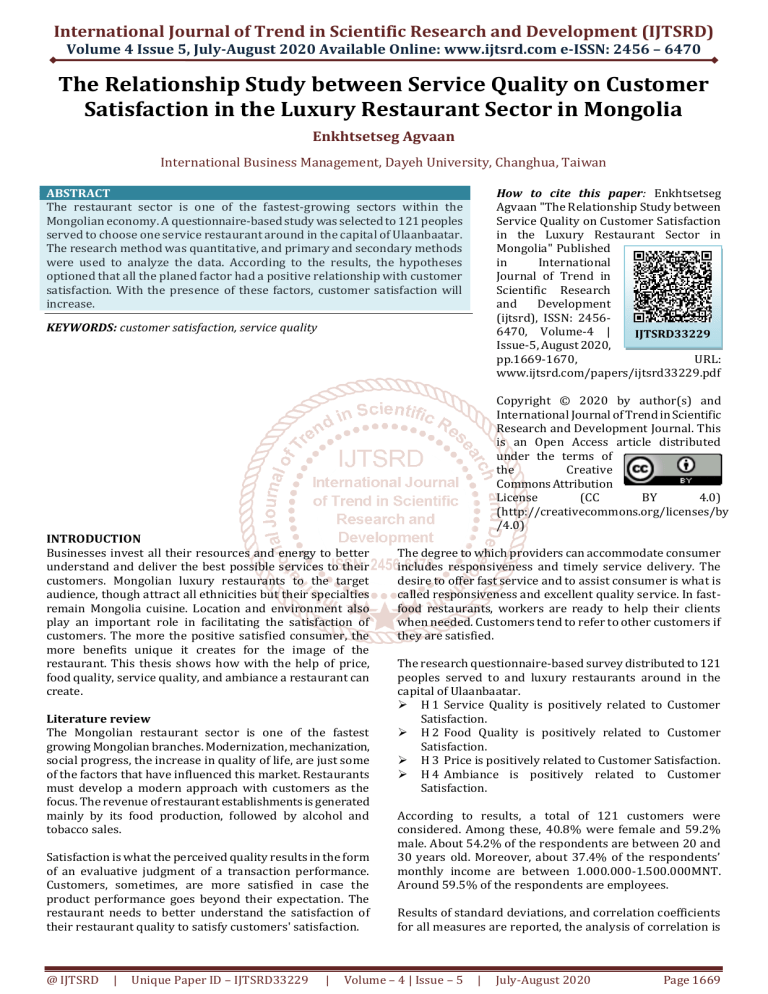
International Journal of Trend in Scientific Research and Development (IJTSRD)
Volume 4 Issue 5, July-August 2020 Available Online: www.ijtsrd.com e-ISSN: 2456 – 6470
The Relationship Study between Service Quality on Customer
Satisfaction in the Luxury Restaurant Sector in Mongolia
Enkhtsetseg Agvaan
International Business Management, Dayeh University, Changhua, Taiwan
ABSTRACT
The restaurant sector is one of the fastest-growing sectors within the
Mongolian economy. A questionnaire-based study was selected to 121 peoples
served to choose one service restaurant around in the capital of Ulaanbaatar.
The research method was quantitative, and primary and secondary methods
were used to analyze the data. According to the results, the hypotheses
optioned that all the planed factor had a positive relationship with customer
satisfaction. With the presence of these factors, customer satisfaction will
increase.
How to cite this paper: Enkhtsetseg
Agvaan "The Relationship Study between
Service Quality on Customer Satisfaction
in the Luxury Restaurant Sector in
Mongolia" Published
in
International
Journal of Trend in
Scientific Research
and
Development
(ijtsrd), ISSN: 24566470, Volume-4 |
IJTSRD33229
Issue-5, August 2020,
pp.1669-1670,
URL:
www.ijtsrd.com/papers/ijtsrd33229.pdf
KEYWORDS: customer satisfaction, service quality
Copyright © 2020 by author(s) and
International Journal of Trend in Scientific
Research and Development Journal. This
is an Open Access article distributed
under the terms of
the
Creative
Commons Attribution
License
(CC
BY
4.0)
(http://creativecommons.org/licenses/by
/4.0)
INTRODUCTION
Businesses invest all their resources and energy to better
understand and deliver the best possible services to their
customers. Mongolian luxury restaurants to the target
audience, though attract all ethnicities but their specialties
remain Mongolia cuisine. Location and environment also
play an important role in facilitating the satisfaction of
customers. The more the positive satisfied consumer, the
more benefits unique it creates for the image of the
restaurant. This thesis shows how with the help of price,
food quality, service quality, and ambiance a restaurant can
create.
Literature review
The Mongolian restaurant sector is one of the fastest
growing Mongolian branches. Modernization, mechanization,
social progress, the increase in quality of life, are just some
of the factors that have influenced this market. Restaurants
must develop a modern approach with customers as the
focus. The revenue of restaurant establishments is generated
mainly by its food production, followed by alcohol and
tobacco sales.
Satisfaction is what the perceived quality results in the form
of an evaluative judgment of a transaction performance.
Customers, sometimes, are more satisfied in case the
product performance goes beyond their expectation. The
restaurant needs to better understand the satisfaction of
their restaurant quality to satisfy customers' satisfaction.
@ IJTSRD
|
Unique Paper ID – IJTSRD33229
|
The degree to which providers can accommodate consumer
includes responsiveness and timely service delivery. The
desire to offer fast service and to assist consumer is what is
called responsiveness and excellent quality service. In fastfood restaurants, workers are ready to help their clients
when needed. Customers tend to refer to other customers if
they are satisfied.
The research questionnaire-based survey distributed to 121
peoples served to and luxury restaurants around in the
capital of Ulaanbaatar.
H 1 Service Quality is positively related to Customer
Satisfaction.
H 2 Food Quality is positively related to Customer
Satisfaction.
H 3 Price is positively related to Customer Satisfaction.
H 4 Ambiance is positively related to Customer
Satisfaction.
According to results, a total of 121 customers were
considered. Among these, 40.8% were female and 59.2%
male. About 54.2% of the respondents are between 20 and
30 years old. Moreover, about 37.4% of the respondents’
monthly income are between 1.000.000-1.500.000MNT.
Around 59.5% of the respondents are employees.
Results of standard deviations, and correlation coefficients
for all measures are reported, the analysis of correlation is
Volume – 4 | Issue – 5
|
July-August 2020
Page 1669
International Journal of Trend in Scientific Research and Development (IJTSRD) @ www.ijtsrd.com eISSN: 2456-6470
one of a most efficient way to check the strength of
association between two variables and the direction of the
relationship. The most widely used type of correlation
coefficient is the Pearson's coefficient correlation. The
results were shown: as predicted SQ,FQ,P,A and CS are
significantly related to each others. The price is higher
(.833**) than other variables, and it is more correlated with
satisfaction than any other variable (price is higher than
ambiance)
Study used are SQ, FQ, P and P as the independent variable,
CS as the dependent variable. The study used gender, age,
and income as the control variables. The regression results
showed that service quality is a good significant predicator
of customer satisfaction. As a result, hypothesis (study
hypothesis) is accepted which confirmed the positive
relationship between service quality and customer
satisfaction. The study was published in the journal
‘Consumer Reports’, published by the American Marketing
Association, Inc. (1989, No. 3). It is the largest consumer
satisfaction study of its kind ever published. The results
show that food quality (food quality, ambiance, price) has a
significant influence on customer satisfaction in the U.S. and
Canada. It is the only study to have published this type of
study in the world’s consumer satisfaction journal, the
American Customer Satisfaction Research Association
(ACRA) journal, published in 1989, no. 4. “Customer
satisfaction’ was the first study to show a positive
correlation between food quality and satisfaction.
According to the analysis, all the proposed hypotheses were
accepted.
Luxury restaurants in Mongolia are expanding their bases in
the country. Price, food quality, service quality and ambiance
are the most important factors. Future researchers can focus
on customer's characteristics, their perception and customer
loyalty and how it affects their satisfaction for a dining
experience in an restaurant. If customers are satisfied with
the restaurant, they will be loyal to it and would come again
and with positive word of mouth, refer to other people as
well.
Reference
[1] Angelova, B., &Zekiri, J. (2011). Measuring customer
satisfaction with service quality using the American
Customer
Satisfaction
Model
(ACSI
Model). International Journal of Academic Research in
Business and Social Sciences, 1(3), 232.
[2] Chinh, V. T. M., & Anh, N. V. (2008). Measuring
customer satisfaction based on the service quality gap
at a local bank in Vietnam. Journal of International
Business Research, 7, 27.
[3] Dutta, K., Parsa, H. G., Parsa, R. A., &Bujisic, M. (2014).
Change in consumer patronage and willingness to pay
@ IJTSRD
|
Unique Paper ID – IJTSRD33229
|
at different levels of service attributes in restaurants: A
study in India. Journal of Quality Assurance in
Hospitality & Tourism, 15(2), 149-174.
[4] Iqbal, H., Ahmed, I., & Nawaz, M. Usman. S, Shaukat, Z. &
Ahmad N.(2010). Effect of Service Quality on Customer
Satisfaction:
Empirical
Evidence
from
the
Telecommunication
Sector
of
Pakistan. Interdisciplinary Journal of Contemporary
Research in Business, 12, 123-129.
[5] Karki, D., &Panthi, A. (2018). A study on Nepalese
Restaurants in Finland: How Food Quality, Price,
Ambiance, and Service Quality Effects Customer
Satisfaction.
[6] Khan, S., Hussain, S. M., & Yaqoob, F. (2013).
Determinants of customer satisfaction in the fast food
industry a study of fast food restaurants Peshawar
Pakistan. Studio Commercial Bratislavensia, 6(21), 5665.
[7] Khan, N. A. (2011). A study of brands in the food and
beverages industry of Pakistan. International Journal of
Business and Social Science, 2, 13.
[8] Kotler, P., & Armstrong, G. (2012). Defining Marketing
and the Marketing Process. Principles of Marketing,
14th Edition, New Jersey: Pearson Prentice Hall.
[9] Raajpoot, N. A. (2002). TANGSERV: A multiple-item
scale for measuring tangible quality in the foodservice
industry. Journal of Foodservice Business Research, 5(2),
109-127.
[10] Ryu, K., & Han, H. (2010). Influence of the quality of
food, service, and physical environment on customer
satisfaction and behavioral intention in quick-casual
restaurants: Moderating role of perceived
price. Journal of Hospitality & Tourism Research, 34(3),
310-329.
[11] Ryu, K., Lee, H. R., & Gon, Kim, W. (2012). The influence
of the quality of the physical environment, food, and
service on restaurant image, customer perceived value,
customer
satisfaction,
and
behavioral
intentions. International Journal of Contemporary
Hospitality Management, 24(2), 200-223.
[12] Van Iwaarden, J., Van der Wiele, T., Ball, L., & Millen, R.
(2003). Applying SERVQUAL to web sites: An
exploratory study. International Journal of Quality &
Reliability Management, 20(8), 919-935.
[13] Wilson, A., Zeithaml, V. A., Bitner, M. J., &Gremler, D. D.
(2012). Services Marketing: Integrating Customer Focus
Across the Firm (No. 2nd Eu). McGraw Hill.
[14] Yoo, S. A. (2012). Customer Perceptions of Restaurant
Cleanliness:
A
Cross-Cultural
Study (Doctoral
dissertation, Virginia Tech).
Volume – 4 | Issue – 5
|
July-August 2020
Page 1670



